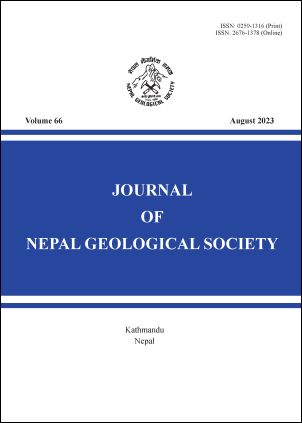Numerical modelling of cut-slope stability in the Lesser Himalayan terrain of west-central Nepal
DOI:
https://doi.org/10.3126/jngs.v66i01.57933Keywords:
Cut-slopes, Lesser Himalaya, slope stability, factor of safety, numerical modellingAbstract
Area development without due consideration of geological factors has led to recurrent slope failures within the Lesser Himalayan Zone thereby rendering socio-economic impacts. This issue is well exemplified by cut-slopes in major highways of Nepal traversing through a diverse range of rocks and soils. The study has focused on addressing the stability challenges posed by highly vulnerable excavated cut-slopes with particular attention given to a debris cut-slope considered as a model for this study is located in the Lesser Himalayan terrain of west-central Nepal. The cut-slope model is analyzed by numerical modellings through both the limit equilibrium method (LEM) and finite element method (FEM). The study further evaluated the underlying causes of these failures to recommend the options for remedial measures. Data acquired from two-dimensional electrical resistivity tomography (2D-ERT), multi-channel analysis of surface waves (MASW), and laboratory testing were integrated into numerical modelling and simulation. The results showed that the lower slope below the natural benching is stable whereas the upper failed slope is unstable due to reduced gravitational loading. In LEM, factors of safety (FoS) range from 0.77 to 0.89 for cut-slope angles of 70° and 60° whereas the FoS in modified slopes (50° and 40°) were slightly greater than 1 which ranged from 1.01 to 1.18 and indicated marginal stability. Application of 25 mm diameter soil nails, each measuring 6 m in length and spaced at 2 m intervals with tensile and plate capacity of 125.6 kN, bond strength of 75.4 kN/m, and 80% of nail length have produced FoS of 1.30 or greater in LEM and FEM which is acceptable values specified by EM 1110-2-1902 and IS 456 2000 for end-of-construction and multistage loadings.
Downloads
Downloads
Published
How to Cite
Issue
Section
License
© Nepal Geological Society




